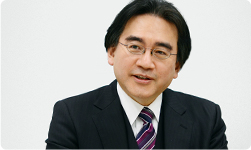What were the first few things that the two of you worked on together?
They were things like middleware11 and a cross-platform real time 3D engine12.11. Middleware: Software that functions between the computer’s operating system (OS) and an application that provides various features.12. Cross-platform real time 3D engine: A kind of game development tool that allows for high-quality 3D graphics on multiple, different game systems. The members of NERD were one of the first teams to anticipate the demand for such a tool, and were working on it as early as 1997.
This was a time when we didn’t have words like middleware or cross-platform engine. You didn’t know what to call what it was you were working on, but you just knew it would be something that would be nice to have. It must have been hard to do business like this when you couldn’t explain what something was until you’d made it, and although we call it a cross-platform engine now, we didn’t have that name back then.
Yes. (laughs) We were starting to worry about why we couldn’t sell our products. We thought they probably weren’t good enough from a technical perspective, and so we were just working and working to make them even better, but they never sold any better. In the end we finally thought that maybe it was a business problem. It took us a very long time to understand that.

You were looking for the answers to your problems in the technical field and not thinking of the business structure. I had exactly the same experience a long time ago. Although I remember it with shame,back then, Miyamoto-san’s13 creations were selling much better than mine, but I couldn’t see why because I thought that mine were technically equal. But the technical aspect was not the only problem. Now I understand it, but at the time I was just trying to make my creations even more technically perfect.
So Mobiclip went on with its history and at one point there was an encounter with Nintendo. I think this is when you met Okada-san14, right?13. Shigeru Miyamoto, Senior Managing Director of Nintendo Co., Ltd.14. Satoru Okada, former General Manager of Nintendo Research & Engineering Department.
Looking back now, I can see that we were young and fearless and didn’t see any limits to what we could do. We were at a trade show in the UK and had just seen some specifications for the Game Boy Advance15, which was launched around that time. We thought that with so many display colours maybe we could include a movie in the software. We weren’t sure whether we would be able to do it, but we were bold enough to go up to the Nintendo booth and look around trying to find someone we could talk to. (laughs)15. Game Boy Advance: A handheld games system first released in Japan in March 2001.It was later released in Europe in June of the same year.
We thought we would have zero chance of getting anything out of it.
Right. And then I saw someone who seemed a bit remote and just walking around, but he seemed to work at Nintendo. He was Japanese and I could see from his badge that he was some kind of general manager, so I realised that he was an important person. So I jumped in and did my piece, saying "we think we can do something great with the Game Boy Advance based on the specs! Please just give us a chance to show it!" But my English wasn’t good enough and I was probably speaking too fast from excitement, so Okada-san didn’t really understand what I was saying.
And your English was probably much more French than it is now.
So I was very disappointed. But he must have thought that something about it was interesting because he came back to the booth we had. But we still struggled to communicate, so I just wrote numbers on a piece of paper. I wrote the resolution of the Game Boy Advance, the frame rate and the number of bits per pixel, and I divided by 100. I was trying to show how much the graphical data can be compressed by this calculation. When Okada-san saw that fraction along with the numbers, it must have rung a bell in his head because he said, “Oh yeah! That’s great!” So the fraction was saying everything.
You couldn’t communicate with words so you were having a conversation with numbers?
From an engineer to an engineer, there is no language barrier with numbers. It’s a universal language.
I think that's really amazing. Your courage to approach Okada-san but also Okada-san's courage to start asking you to do something. (laughs) I can still remember when Okada-san came back and he told me, "I met some interesting people in France and I've asked them to work on something to see what they can do."
I didn’t know that he talked to you about us. (laughs)
So at the beginning the company was still called Actimagine16 and your first product for Nintendo was this video codec17. Developers in Japan were very surprised to see that video codec working on the “very poor” CPU of Game Boy Advance. “Very poor” means here that its architecture18 was not very good at performing such tasks. If you had just applied a conventional video codec algorithm19, it wouldn’t have worked.16. Actimagine: The company that later became Mobiclip, then NERD.17. Video codec: A hardware or software module implementing compression and decompression of video files.18. Architecture: The concept for the hardware and software design philosophy required for the development of high level and complicated programs and systems. Used here in the sense of the hardware structure of a games console.19. Algorithm: A procedure for a computer to carry out a process.
At the time the industry consensus was that if you wanted a video codec, you needed hardware for that. But as we had no hardware skills we were trying to show that we could do something else.
So you could say that you were able to do it specifically because you didn’t really understand it. (laughs) If you thought it was impossible, maybe you wouldn’t have tried. But your team were probably thinking that they just needed to try, and then they would be sure to find a way. You had this conversation with Okada-san in numbers and you were confident that if you had a way, you would be able to make it work.
I think that energy is still alive in your company today. You’re the kind of people who will take things you would normally think were impossible and make them work.
Actually, when we started the company we had many people telling us that we wouldn’t succeed, that we would fail. Whenever we heard this we would just say, “You’ll see.” It’s even more exciting when you attack a problem which is considered impossible. This pushes you to go further, to push your limits. Nobody’s done it before, but if I try, maybe I can. If I’m bold enough, maybe I don’t see it as being impossible.
You are basically tackling problems from two sides: the computer programming side and the mathematical side. This approach is one of the very interesting things about NERD.

© 2024 Nintendo.